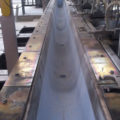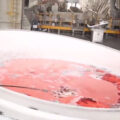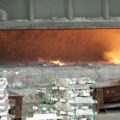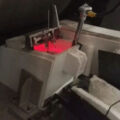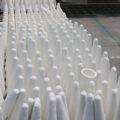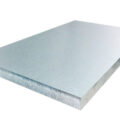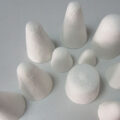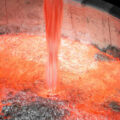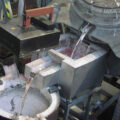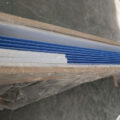In the world’s non-ferrous metal production, the annual output of aluminum has always been the first, far exceeding other non-ferrous metals. The amount of refractory materials consumed by the aluminum industry each year is far greater than the total amount of refractory materials consumed in the smelting of copper, lead and zinc. According to the development history of the aluminum smelting industry, refractories for continuous casting are divided into two types: refractory for electrolytic aluminum and refractory for aluminum smelting furnaces.

Refractory for continuous casting refers to materials made by melting, crystallization, annealing and cold working of raw material batches.
The production of modern electrolytic aluminum industry uses cryolite-alumina molten salt electrolysis.
The molten cryolite is the solvent, the alumina is used as the solute, the carbon body is used as the anode, and the aluminum liquid is used as the cathode. After applying strong direct current, the electrochemical reaction is carried out on the two electrodes in the electrolytic cell at 900°C-1000°C. The electrolyte and aluminum are kept in a molten state, and the aluminum liquid is periodically discharged from the tank, and a certain amount of alumina and cryolite are added to the tank.
Since the electrolyte (such as cryolite) added during the electrolysis process cannot be completely electrolyzed, the excess part and gas phase above the melt will cause severe corrosion to the refractory.
The aluminum smelting furnace is a new type of high-efficiency and energy-saving aluminum smelting furnace developed based on the aluminum smelting process. It can well meet the requirements of strict alloy composition, discontinuous production and large single furnace capacity in the aluminum smelting process. Reduce consumption, reduce combustion loss, improve product quality, reduce labor intensity, improve working conditions and increase production efficiency.
During its working process, since the viscosity of molten aluminum at 750°C is very close to that of water at 20°C, it is easy to penetrate into the furnace lining and cause chemical reactions. When molten aluminum is in contact with refractory materials, the oxides in the refractory materials (such as SiO 2, TiO 2, Fe0) are easily reduced by aluminum, thereby forming nodules, protrusions and precipitated debris on the surface of the furnace lining.
During the operation of the furnace, the molten metal in the furnace is constantly agitated and agitated, constantly scrubbing and abrading the furnace lining, and the part immersed in the molten aluminum is in danger of infiltration and cracking. When the aluminum in the furnace is melted, it will also cause peeling. The stove is off.
Therefore, the lining material in contact with molten aluminum must have high thermal stability and as little impregnation as possible, while also requiring high mechanical strength and hardness.


